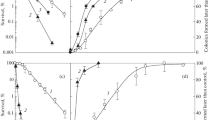Summary
The responses to UV irradiation of pre-meiotic and meiotic cells of the unicellular green alga Chlamydomonas reinhardi have been examined in a wild type and a UV-sensitive mutant (UVS1) strain. During late interphase and early prophase the cells become highly sensitive to UV under dark conditions, but show much less change in sensitivity following photoreactivation (PR). At these times the effect of PR is not dose-modifying, but very large PR factors are obtained — at the 50% survival level in some stages values up to 23 being obtained. The enhancement of dark sensitivity is attributed to a diminution in dark repair activity, and it is suggested that this is associated with the process of genetic recombination that occurs in these meiotic cells. In addition at those times when the dark repair capacity is at a low level, a phenomenon akin to UV reactivation occurs, in that within a certain dose range, survival increases with increasing dose. The possible basis of this phenomenon is discussed.
Similar content being viewed by others
References
Boyce, R. P., and P. Howard-Flanders: Release of ultraviolet induced thymine dimers from DNA in E. coli K12. Proc. nat. Acad. Sci. (Wash.) 51, 293–300 (1964).
Clark, A. J., and A. D. Margulies: Isolation and characterisation of recombination deficient mutants of E. coli K-12. Proc. nat. Acad. Sci. (Wash.) 53, 451–459 (1965).
Davies, D. R.: Repair mechanisms and variations in sensitivity within the cell cycle. Mutation Res. 2, 477–486 (1965).
— Patterns and rates of recovery in synchronous populations of algal cells exposed to gamma radiation. Radiat. Res. 29, 222–235 (1966a).
— Acriflavine inhibition of dark repair and late generation death. Biochem. biophys. Res. Commun. 23, 652–659 (1966b).
Davies, D. R. UV sensitive mutants of Chlamydomonas reinhardi. Mutation Res. (in press).
—, and C. W. Lawrence: The mechanism of recombination in Chlamydomonas reinhardi. II. The influence of inhibitors of DNA synthesis on intergenic recombination. Mutation Res. 4, 147–154 (1967).
Harm, W.: On the relationship between host cell reactivation and UV-reactivation in UV-inactivated phages. Z. Vererbungsl. 94, 67–79 (1963).
Holliday, R.: A mechanism for gene conversion in fungi. Genet. Res. 5, 282–304 (1964).
—: Altered recombination frequencies in radiation sensitive strains of Ustilago. Mutation Res. 4, 275–288 (1967).
Howard-Flanders, P., and R. P. Boyce: DNA repair and genetic recombination: studies on mutants of Escherichia coli defective in these processes. Radiat. Res. Suppl. 6, 156–184 (1966).
Jacob, F., and E. L. Wollman: Etude génétique d'un bactériophage tempéré d'Escherichia coli. III. Effet du rayonnement ultraviolet sur la recombinaison génétique. Ann. Inst. Pasteur 88, 724–749 (1955).
Kellenberger, G., and W. Arber: Quoted by Harm (1963).
Lawrence, C. W.: Influence of non-lethal doses of radiation on recombination in Chlamydomonas reinhardi. Nature (Lond.) 206, 789–791 (1965).
Mattern, I. E., M. P. Van Winden, and A. Rorsch: The range of action of genes controlling radiation sensitivity in Escherichia coli. Mutation Res. 2, 111–131 (1965).
Meselson, M., and J. J. Weigle: Chromosome breakage accompanying genetic recombination in bacteriophage. Proc. nat. Acad. Sci. (Wash.) 47, 857–868 (1961).
Nakai, S., and S. Matsumoto: Two types of radiation sensitive mutant in yeast. Mutation Res. 4, 129–136 (1967).
Oppenheim, A. B., and M. Riley: Molecular recombination following conjugation in Escherichia coli. J. molec. Biol. 20, 331–357 (1966).
Setlow, J. K.: The molecular basis of biological effects of ultraviolet radiation and photoreactivation in current topics in radiation research, II (eds. M. Ebert and A. Howard). Amsterdam: North-Holland Publ. Co. 1966.
Setlow, R. B., and W. L. Carrier: The disappearance of thymine dimers from DNA: An error correcting mechanism. Proc. nat. Acad. Sci. (Wash.) 51, 226–231 (1964).
Siddiqi, O. H.: Incorporation of parental DNA into genetic recombinants of E. coli. Proc. nat. Acad. Sci. (Wash.) 49, 589–592 (1963).
Strauss, B., T. T. Searashi, and M. Robbins: Repair of DNA studied with a nuclease specific for UV induced lesions. Proc. nat. Acad. Sci. (Wash.) 56, 932–939 (1966).
Weigle, J. J.: Induction of mutations in a bacterial virus. Proc. nat. Acad. Sci. (Wash.) 39, 628–636 (1953).
Whitehouse, H. L. K.: A theory of crossing over by means of hybrid deoxyribonucleic acid. Nature (Lond.) 199, 1034–1040 (1963).
Author information
Authors and Affiliations
Rights and permissions
About this article
Cite this article
Roy Davies, D. The control of dark repair mechanisms in meiotic cells. Molec. Gen. Genetics 100, 140–149 (1967). https://doi.org/10.1007/BF00333600
Received:
Issue Date:
DOI: https://doi.org/10.1007/BF00333600



